 Cricket has a reputation in some quarters for being a sport that is difficult to understand. Part of this reputation comes from the many (sometimes quite obscure) rules and regulations that govern the various formats of the game. Many rules in cricket are relatively easy to understand, such as when a player is declared out or when an umpire should declare a no ball. But sometimes circumstances arise in a cricket match that require something a little more elaborate than just an umpire’s call.
Cricket has a reputation in some quarters for being a sport that is difficult to understand. Part of this reputation comes from the many (sometimes quite obscure) rules and regulations that govern the various formats of the game. Many rules in cricket are relatively easy to understand, such as when a player is declared out or when an umpire should declare a no ball. But sometimes circumstances arise in a cricket match that require something a little more elaborate than just an umpire’s call.
One such situation is when rain (or something else) interrupts play in a limited-overs match and the rather complex Duckworth-Lewis-Stern (DLS) method comes into play. If you haven’t the foggiest idea what we’re talking about, fear not, because in this article we’ll give you a solid oversight of what the DLS is, why it is needed and what alternatives were used before its official introduction in 1997 (when it was called simply the Duckworth-Lewis (D/L) Method – not to be confused with the cricket-loving Irish pop group of the same name!).
What Is The Duckworth-Lewis-Stern (DLS) Method And Why Is It Required?
There is no quick and easy way of explaining this, so pay attention: the DLS is a mathematical mechanism that is used to ascertain the target score* required for a team batting second in a limited overs cricket match to win the match when the match has been interrupted by rain, general bad weather or anything else that means the number of overs has to be reduced. Essentially it is a way to decide how many runs the team batting second needs to score to beat the team that batted first. It was devised by British statisticians Frank Duckworth and Tony Lewis (Professor Stephen Stern became the “custodian” of the method after the other two men retired, and his name was added in 2014 following alterations to the maths behind the system.)
*For those who are not already familiar with the term, the target score refers to the score the team that bats second has to score in order to win the match. In matches that have not been interrupted by rain, bad light or anything else, i.e. in no overs are lost, the target score will simply be one more than the number of runs scored by the team that batted first.
Before we delve into exactly how the DLS works, let’s first briefly explain why it is even required. Before it was adopted as the method used to calculated revised targets in limited overs cricket that had been interrupted, the revised targets were based on one of two methods:
The Average Run Rate Method
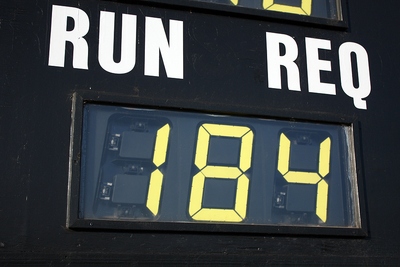 This method simply reflected the average runs scored per over by the batting team at the point when the match was interrupted. It was not adjusted for the number of wickets that had been lost, nor the number of overs bowled. Thus if a team suspected it was going to rain in the not-too-distant future, they could throw caution to the wind to up their run rate in the hope of producing a revised target for the other side that was higher than it would have been. They would not worry too much about losing wickets in this scenario if they had a few in hand and they thought their innings would be stopped by rain shortly anyway.
This method simply reflected the average runs scored per over by the batting team at the point when the match was interrupted. It was not adjusted for the number of wickets that had been lost, nor the number of overs bowled. Thus if a team suspected it was going to rain in the not-too-distant future, they could throw caution to the wind to up their run rate in the hope of producing a revised target for the other side that was higher than it would have been. They would not worry too much about losing wickets in this scenario if they had a few in hand and they thought their innings would be stopped by rain shortly anyway.
The fact it did not consider how many overs either side had faced, or would have to chase the target in, also made it less accurate than desirable. Teams usually increase their scoring rate in the later stages of an innings. In addition, if they know the match is 25 overs rather than 50, they can be more aggressive because the opposition has fewer overs with which to claim their wickets.
The Most Productive Overs Method
 To try and improve this rather blunt tool, an alternative method replaced the Average Run Rate Method in 1991. However, the Most Productive Over Methods also ignored the number of wickets that had been lost, though it did go some way to addressing the issue of overs. This new method was based on the runs scored in the highest-scoring overs of the team who batted first.
To try and improve this rather blunt tool, an alternative method replaced the Average Run Rate Method in 1991. However, the Most Productive Over Methods also ignored the number of wickets that had been lost, though it did go some way to addressing the issue of overs. This new method was based on the runs scored in the highest-scoring overs of the team who batted first.
The number of overs used would be equal to how many overs the second team to bat would have in which to reach a revised target (e.g. if team two had 12 overs in which to reach a target, this target would be based on the number of runs scored by team one in their best 12 overs).
The main problem with this method was that the second side didn’t reap the benefit for good bowling as the best overs (from their point of view, when bowling) were ignored in the calculation. This was especially the case when they bowled maidens (in which no runs were scored) as this could leave them having to score the same number of runs as the first team, but in fewer overs, which would be seen as unfair by most fans and pundits.
Such a method might be ok if the team knew in advance about the modified target. For example, chasing 300 in 49 overs is little different from chasing 300 in 50 but the system did not take into account how much of the game remained, as we shall see. Apart from all that, it was a tricky method to administer on the day of the game with umpires having to take the time to calculate the new target.
Why Was The DLS Method Required?
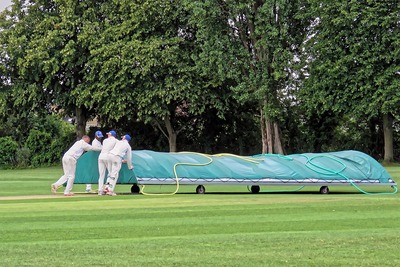
The easiest way to explain why the Duckworth-Lewis-Stern Method (or something other than the existing methods) was required is to give an example of what happened on occasion under the old methods. The semi-final of the 1992 Cricket World Cup between England and South Africa gives the perfect example.
After a rain delay and some slow South African bowling, the match was reduced to 45 overs for each side and England, who batted first, scored 252/6 from their allotted overs. South Africa took up the chase in decent enough style but rain interrupted play just before the last ball of the 43rd over of their innings at which point they had reached a score of 231/6. The rain caused an interruption of 12 minutes which meant two overs were dropped and thus just one ball remained. Based on the abovementioned Most Productive Overs Method, it was (eventually – neither side, nor the officials, really seemed to know what was going on!) calculated that South Africa’s revised target would be to score 21 runs… from one ball!
Clearly, there was no way South Africa could manage that all-but-impossible feat (they managed two runs off the ball, for the record) and the whole situation left players on both sides feeling a little non-plussed, to say the least. Not to mention the radio commentators, with the BBC’s Christopher Martin-Jenkins opining, “surely somebody, somewhere could come up with something better”. Luckily for CMJ, and the wider cricketing world, statistician Frank Duckworth was listening and he thought he might have a bash at a better system.
Incidentally, had the Duckworth-Lewis Methods been employed in the England versus South Africa semi-final in 1992, South Africa would have been given a revised target of five runs, which would still have been a big ask, but – in most people’s eyes – would have been a much fairer reflection of the state of the game at the point at which rain intervened.
How Does The Duckworth-Lewis-Stern Method Work?
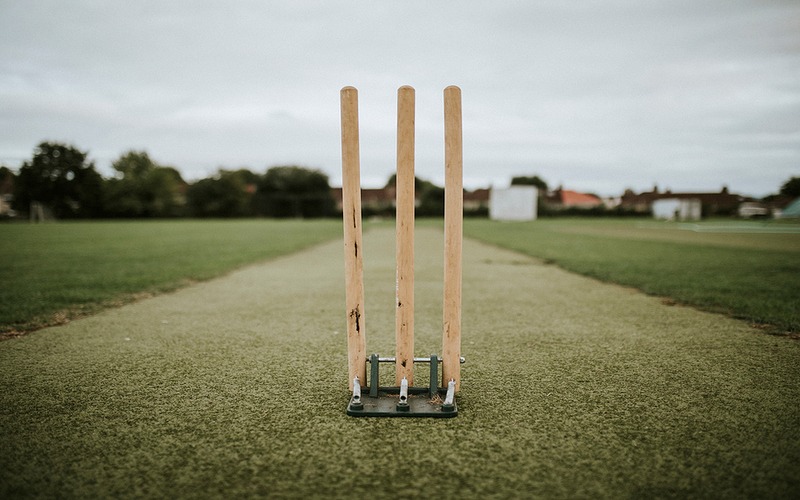
So now we’ve got an idea about why the DLS was required in the first place, let’s tackle the potentially tricky task of explaining how the thing actually works. From a cricketing point of view there are some fairly obvious factors that needed incorporating into a system. Wickets, runs and overs are the three major variables to consider, whilst it is also necessary to try and keep both sides, the crowd and the media up to date with the current state of play in relation to any rain delay.
The creators of the formula also knew that they had to consider how rain might impact both the scoring in the first innings and the scoring in the second. So, for example, if a side believed they were trying to set a 50-over score but the game was reduced to 30 overs, the side batting second, who knew from the start they only have 30 overs, would have an advantage unless their target was scaled up. In other words, when and how the overs are lost is also important in trying to create a fair revised target, with the number of overs and wickets a side has remaining when play is interrupted taken into account.
For those of a mathematical bent, it’s worth knowing that there is an exponential decay relationship between the number of runs that can be scored by a team based on the number of overs remaining and the number of wickets that have been lost. We won’t go into the specific formula used, but the gist is rather intuitive: the fewer overs there are, the less runs are likely to be scored, and the fewer wickets in hand a side has, again, the fewer runs are likely to be scored. The first part of this notion is one of opportunity; clearly you can only score runs if you have balls to score off.
When you run out of overs (and hence balls) you cannot score any more runs. The second point is more to do with skill (with a bit of psychology thrown in for good measure); that is to say, the best batters are generally placed higher up the order in the line-up, so the more wickets have been lost, the less likely it is you have your best batters in (or yet to be in) and hence you are – in theory at least – likely to score fewer runs. In addition, the more wickets a side has lost, the greater their chances of being bowled out and the fewer risks the current batters are able to take.
Using various combinations of the number of overs remaining and the wickets in hand a figure known as the “resources remaining” is calculated. These run-scoring resources are then converted into a revised target based on the situation at the time. So if a team’s innings is not interrupted, their resources would be 100%. This is reduced based on the number of overs lost to rain (for example) and the number of wickets that have been lost.
Of course, there have been many anomalies in cricket matches over the years in which last-wicket partnerships have miraculously saved games that looked dead and buried (or at the very least sent shivers down the spines of their opponents). But statistics, by their nature, allows for anomalies and pushes them to the side while focusing on the most likely outcomes in any given situation. In this way, though the DLS method is not perfect, it is as good a fit as anything that’s come before or that will probably be developed in the future.
Examples Of The Duckworth-Lewis-Stern (DLS) Method
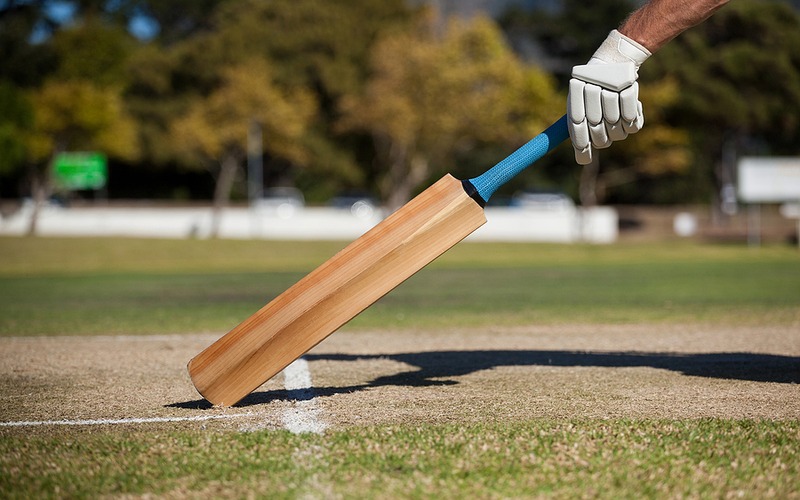
For a game that is so affected by the weather, it should come as no surprise that things are not always as easy as they could be when attempting to ascertain a fair revised target in a given cricket match. But thankfully the Duckworth-Lewis-Stern method is robust enough to deal with stoppages in the first innings, the second or indeed both (and even more than one in each innings).
Multiple stoppages in a limited overs game is almost certainly going to provide a less-than-satisfying spectacle and probably result too, at least from the point of view of the spectators. However, by and large the new system is considered to be pretty much as good as it gets in terms of trying to create a fair target. Let’s take a look at an example of when the DLS has been used.
Second Innings Delay: Zimbabwe v England, 1st Jan 1997
The first match to utilise the Duckworth-Lewis method (long before Stern got involved) was when Zimbabwe hosted England in an ODI at Harare in 1997. Zimbabwe batted first (after England opted to field after winning the toss) and were bowled out for 200 in 48.5 overs. England’s innings was delayed due to rain and the revised target was 185 from 42 overs (although it later transpired that it should have been 186… teething problems were clearly apparent with the new method). It mattered not, however, as England only managed to score 179/7.
Rain Washout In ICC Trophy: NZ v Australia, 2nd June 2017
A more recent example shows that when the rain comes is important in altering the total. At the 2017 ICC Champions Trophy NZ started well and reached 67/1 from nine and a half overs when a rain delay reduced the match to 46 overs. The Kiwis made 291 and Australia’s target was unaltered at 292.
If New Zealand had been 67 without loss when the rain came, Australia’s target would have been a shade higher, reflecting the Kiwi’s greater scoring potential with 10 wickets left. In contrast, stats show that if they had been four down, the target score would have been lower at 284. In the end more rain came between the innings, reducing Australia’s target to 235 from 33 overs, the higher run rate reflecting the shorter game.
In the end yet more rain curtailed the match when Australia reached 53/3 from nine overs. At the time they needed 182 from 24 overs at almost 7.6 runs per over with just three wickets left. However, both sides must face at least 20 over for a result to be declared and so in the end, despite all the best efforts of Duckworth, Lewis and indeed Stern, the game was declared a no result and the honours shared. NZ skipper Kane Williamson commented that DLS tends to favour the side batting second, whilst Aussie counterpart Steve Smith agreed that his side had gotten away with one thanks to the rain.
Ultimately no system can be perfect in all scenarios but the current DLS formula has few critics. Note that similar principles apply whether the interruption occurs (or interruptions occur) in the first innings, the second, or both. And though the specific maths behind the figure that emerges as the revised target can be seen to be a little complex, the logic is sound and the targets are rarely as fantastically “out there” as that mentioned above that arose from the Most Productive Overs Method.
Par Score And Target Score
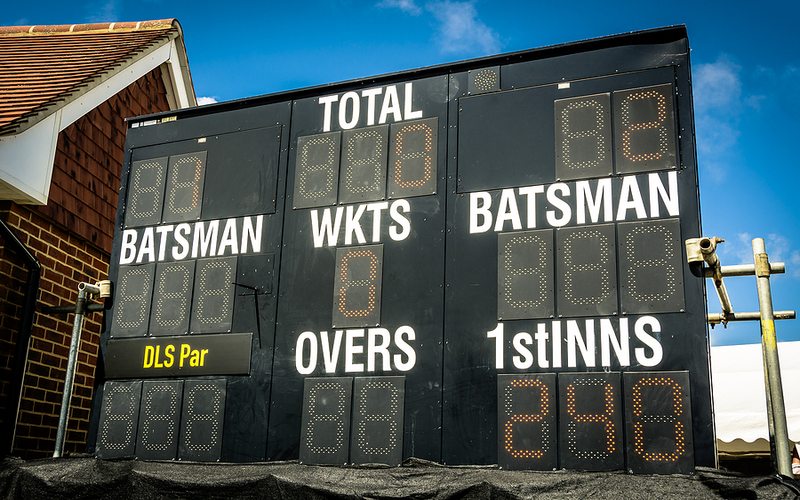
We have already explained what a target score is. In short, it is the real-world target a side must achieve in order to win the game after an interruption and DLS has been used. Par score is a little different but is incredibly helpful for players and fans. The par score is often shown on the scoreboard when a side is batting second and indicates the score they would need to be on to win the game if rain stopped play at that very moment.
It is useful for supporters, and also potentially for betting, because it gives an idea of the current state of play and goes some way to answering that tricky question from non-cricket fans: who is winning? If rain is forecast it is very useful for players though as they have a better idea of whether to attack or defend.
It is also very interesting for those who want to better understand the way DLS works because they can see the formulation work in real time. As each ball passes the par score will change but the biggest change comes when a wicket falls. A side may be right up with par, let’s say on a score of 66/1, but if they slip to 66/2, the par score may jump from 66 to 75, reflecting the far greater difficulty of chasing a score with fewer wickets in the tank.
Looking at another ICC Champions Trophy game from 2017 between Bangladesh and Australia gives us a real world example to consider. Bangladesh made 182 (they were bowled out in less than 45 overs in a game that was unaffected by rain at that stage). David Warner helped the Aussies to 83/1 after 16 overs when rain came down. With 20 overs the minimum needed to declare a result, the par scores for Australia after 120 balls were as follows, varying according to how many wickets they had lost.
- 41/0
- 48/1
- 58/2
- 69/3
- 84/4
As we can see, the loss of the first wicket creates an increase of seven runs but the loss of the second means par would be 10 runs higher. This reflects that going from having 10 wickets left to nine is less detrimental to a team than going from nine to eight. By the fourth wicket, a further 15 runs are required. Taking that to an extreme, when you go from being eight down to nine down, your remaining wickets drop by 50% so the significantly higher par score is easy to understand.
As we can see, in this scenario Australia were well ahead of the game but if a chasing side is only narrowly ahead of par it is prudent for them to be cautious if rain is expected. One or two quick wickets could see them rapidly drop beneath the required par, meaning they would lose the game if weather (or anything else) meant that no further play was possible. In contrast, if a side is behind DLS par they know they need to take some risks but at the same time can ill afford to lose wickets.
Conclusion
There are many people – even cricket fans – who will never fully understand every rule of the game. And there are even more who will never truly understand the Duckworth-Lewis-Stern Method. But, ultimately, it doesn’t really matter. The point is that the DLS is as good a method as is likely to appear to ascertain a fair target for a team to chase. And though it can never be perfect (there are just too many variables for that as well as factors such as changes in conditions or good old fashioned luck), in general most players and pundits accept that it works fairly well in most cases. And it certainly works a whole lot better than the methods that came before it… the South Africa side of 1992 will certainly vouch for that!
